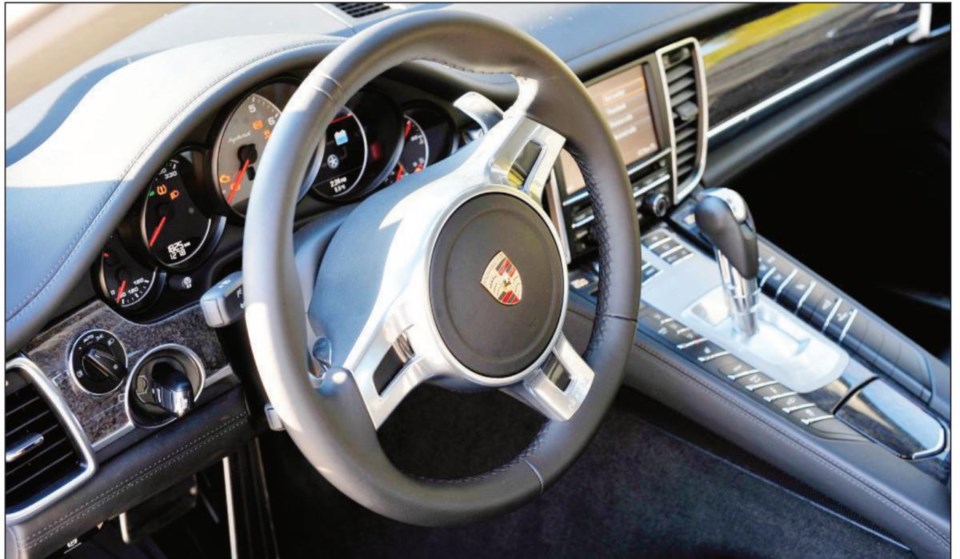The engineers at Porsche obviously wanted to disprove the old saying "You can't have your cake and eat it, too." The 2012 Panamera S Hybrid gives owners the power they expect from a Porsche, but with better gas mileage than a four-cylinder Honda Accord in the city.
What makes the comparison so unlikely is that the Panamera is a full-size luxury sedan typically considered alongside BMW's 7-Series and the MercedesBenz S-Class in price, performance and fuel economy.
The hybrid system in the Panamera is not new - it was used in the Porsche Cayenne. It consists of a direct-injection 3.0-litre V-6 with 333 hp mated to a 34-kilowatt electric motor that produces 47 hp, for a combined 380 hp and 428 lb.ft. of torque. Maximum torque hits at just 1,000 r.p.m.
The Hybrid S has 80 horses more than a base Panamera and 20 less than a conventional Panamera S.
Power is delivered to the ground via an eight-speed automatic to the rear wheels. It is unique in the Panamera model range, as it is not available with the seven-speed PDK, nor as an all-wheel-drive.
The hybrid has a 1.7-kWh nickel-metal hydride battery nestled under the rear cargo area. This small battery is only good for about 2 1/2 kilometres of pure electric driving, achieved by pressing the E-Power switch on the console. With the electric-only switch engaged, a driver can go up to about 50 km, which is great for stop-and-go traffic.
But most of the time, drivers will likely leave it in regular hybrid mode, in which the engine shuts off when the vehicle is coming to a stop and restarts when traffic gets moving - a system identical to some hybrids on the market.
What does set the Porsche hybrid system apart from others is its "sailing mode," which is more noticeable on the highway. The system shuts off the engine when there is no pressure on the gas pedal on the highway, for example when you're approaching an intersection, and lets the car coast until you press the gas pedal again. It's an eerie feeling to travel along the highway at 100 km/h and look down and see the tachometer reading zero - indicating the engine is turned off.
Porsche says this feature is active all the way up to 165 km/h. The system also works in town, but is less noticeable.
Coasting and using the brakes recharges the battery, just like on any other hybrid.
Click on the car menu and among the diagrams explaining gasoline and battery usage is a screen called Engine Off Time. The bar graph display breaks the last half-hour of driving into five-minute intervals. Each one indicates the percentage of time the car has spent with the engine off. It's eyeopening to see how much time the engine spends off in regular city driving. On one occasion, the Panamera recorded the engine off 71 per cent of the time.
The gas gauge on my car hardly moved in 100 km of driving.
But there is also the traditional side of the Panamera. Being a Porsche, it has a Sport button, which firms up the air suspension, changes the shift points and scoots smartly. Porsche claims a zeroto100 km/h dash of six seconds and a top speed of 270 km/h. This is one of the fastest hybrids on the market, certainly the fastest I have ever driven.
Drivers who like to canyon carve will want to engage the Sport button. Left in the default Normal mode, the Panamera's suspension is soft.
Note that in Sport mode, the regular hybrid features are suspended and the engine remains running at stop lights.
Save for "hybrid" badges on its flank and trunk lid, the hybrid looks identical, inside and out, to a regular Panamera S.
The interior of the Panamera is like that of an executive jet, with buttons, gauges and dials - all legible but jewel-like in their appearance. The only niggling complaint is the size of the sunroof, which is tiny. Even the new 911 has a larger roof. A rear blind (which is available) should have been standard equipment.
Pro-basketball players will find front legroom to their liking. Even with the seat all the way back, there is a wee bit of knee room for the rear passenger. The Panamera is a four-seater only and the rear seats are shaped just like the front ones.
The Panamera is a hatchback and there is ample room for golf clubs and other items that lie flat. The back seats fold down for larger items.
With a starting price of $108,700, the Panamera Hybrid won't likely be on the shopping lists of economy-minded drivers. But for those looking for a luxury/sports sedan that can deliver power and fuel economy at the same time, the Panamera Hybrid is the one to beat.
THE SPEC SHEET
Type: Full-size luxury/sports four-door hatchback Engine: Direct-injection 3.0-litre V-6 with 333 hp at 5,500 to 6,500 r.p.m., 325 lb.-ft. of torque at 3,000 to 5,250 r.p.m.
Electric motor: 34-kilowatt electric motor that produces 47 hp and 221 lb.-ft. of torque
Combined power: 380 hp at 5,500 r.p.m. and 428 lb.-ft. of torque at 1,000 r.p.m.
Battery: 1.7 kWh nickel-metal hydride
Transmission: Eight-speed automatic
Dimensions (mm): Length, 4,970; width, 1,931; height, 1,418; wheelbase, 2,920
Curb weight (kg): 1,980
Price (base/as tested): $108,700/$127,395 (includes $1,115 freight and $100 AC tax)
Options: Metallic paint $3,590, leather $4,170, 20-inch wheels
$3,860, park assist $1,440, Sport Chrono package $1,100, Bose audio $1,650, Birch Anthracite interior $1,140, wheel spacers $530
Tires: 255/40 ZR 20 front and 295/35 ZR 20 rear
Fuel type: Premium
Fuel economy (L/100km): 8.6 city/ 6.8 highway
Warranty: Four-years/80,000 km new car and roadside assistance



